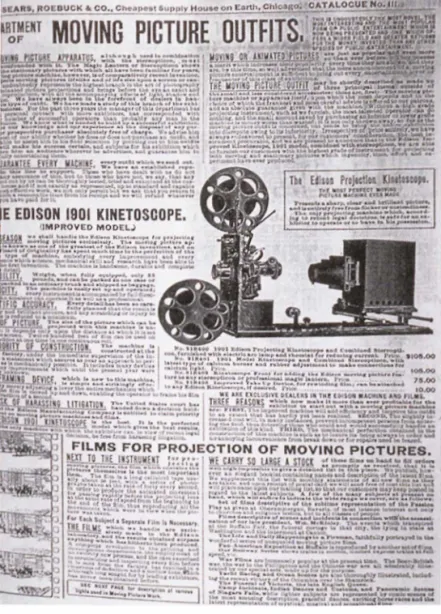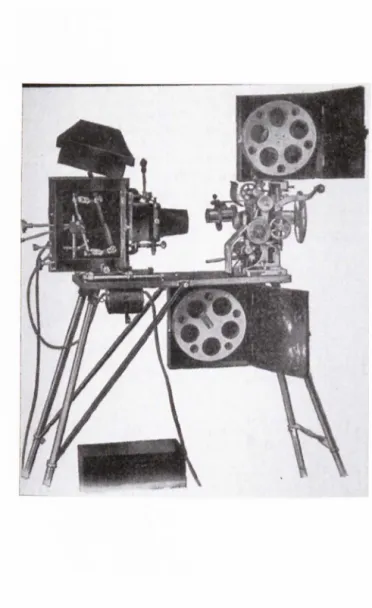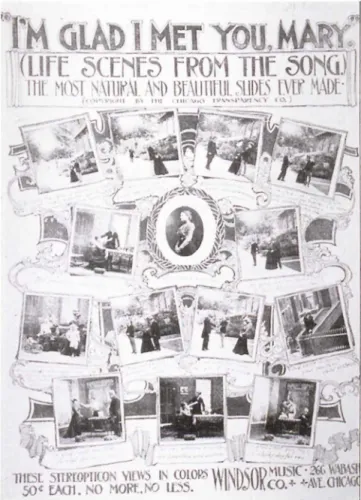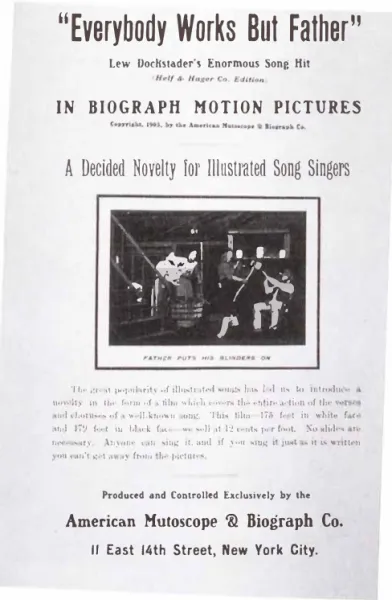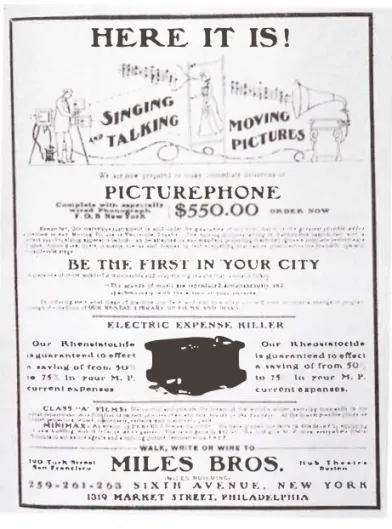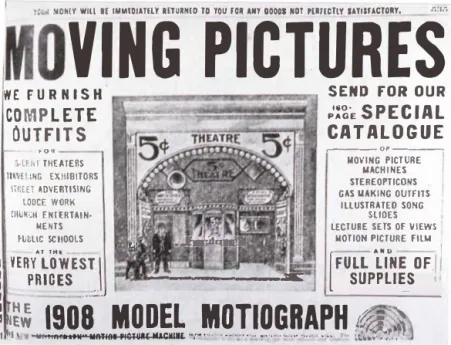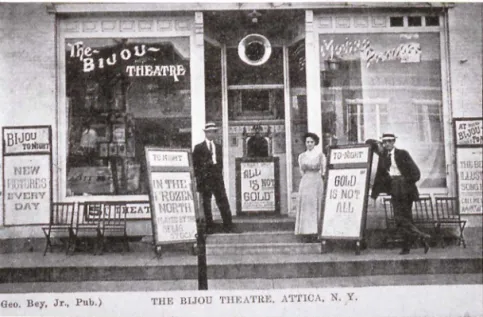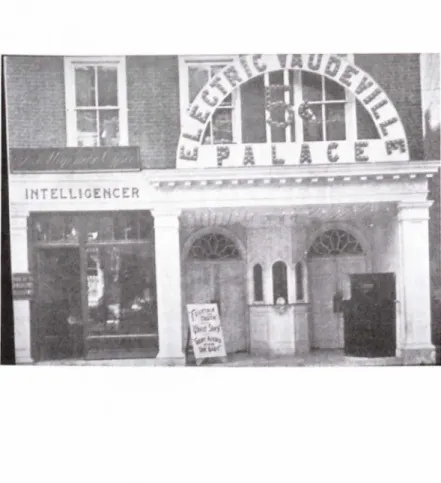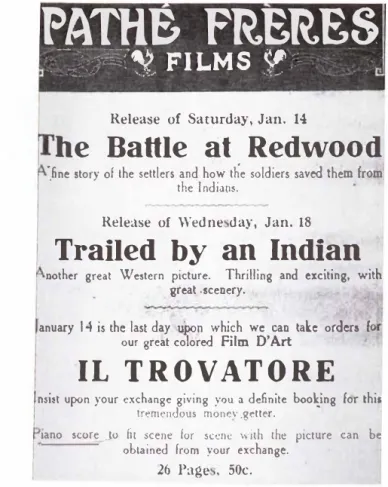Cinema Sound at the Crossroads:
A Century of ldentity Crises
Rick ALTMAN University ollowa
First, I will provide the widest possible historical context along with a clearly targeted theoretical investment and purpose in order to deal with the problems ofsound as a whole. Second, [ will be introducing ten key moments in the history of sound, and explaining why each deserves to be considered important. Together, they will give us a sense of the span of sound problems that we need to be dealing with. Third, l will here be testing a new approach to the historiography of sound that I have been working on for a number of years. Concentrating on a series of identity crises, this new approach may appropriately be term "crisis h istoriography."
ln order to think intelligently about new technologies, we are sys tematically condemned to considering multiple technologies at the same time -not just the one that we are ostensibly studying but also several other related technologies as well. Anyone who thinks about cinema before 1915 must always consider a dozen other forms of entertainment, exhibition venues, or industries. In order to deal with the conversion to sound in the late I 920s, it is impossible to avoid dealing with telephony, public address, phonography, and radio -a wide variety of technologies that today no longer seem directly related to cinema. But when tech nologies are young, nothing reveals that they will eventually become the technologies we know today.
Identity crises occur when a technology is presented as belonging to multiple media simultaneously, eventually precipitating a jurisdictional struggle among those media. Which of the many definitions and attribu tions of the new medium will in fact hold? I will use the term jurisdic tion to mean a number of things. ln its most literai sense, it designates the kind ofjurisdiction that trade unions have. Who has the right in 1929 to operate the new sound systems? The electricians, who insist that the new sound system is electrical? The projectionists, who note that the new sound system is attached to their projectors? The stage workers, who belong to the International Association of Theater and Stage
Engi-14
neers (IA TSE), traditionally responsible for sound effects and equip ment? Or is it the American Federation of Musicians, whose members have been done out of jobs by the new technology? During the late 1920s, movie theaters in man y countries played host to a literai jurisdic tional conflict, with multiple trade unions fighting for the right to exer cise jurisdiction over sound film jobs. The notion of jurisdictional conflict may also be taken as a useful metaphor for the broader jurisdic tional question of which model will govern the development of sound film -the mode! provided by radio or the model derived from phono graphy, the model that cornes from engineering or the model of live music for si lent films?
Jurisdictional struggles may last only a short period of time, or they may go on for decades. Only at the point where a settlement is negoti ated can any kind of standardization be achieved. This negotiated set tlement almost always involves simultaneously meeting the demands of most unions or industries fighting over the new technologies. Satisfying only a single group leaves too much energy in the system, as it were. Eventually, the energy in the system must corne back to haunt the apparent winner. Only by satisfying a maximum number of participating players can a negotiated settlement bring an identity crisis to a close.
Far from following a neat linear or teleological path, identity crises corne back again and again, overlapping and interweaving. lnstead of a clear progression from identity crisis to jurisdictional struggle to negoti ated settlement, history offers us instead a complex fabric where ail three processes are simultaneously at work. In order to understand the process by which new technologies sometimes succeed in achieving recognition and stability, we must catch them at the point where they have not yet succeeded. Only by studying sound's identity crises can we understand how sound technologies became the media that we know and recognize today.
lronically, the best way to begin this study is by attending to the moments when sound sounds "wrong". Most historians operate retro spectively, identifying and defining the objects of their attention through a lens provided by later developments. For these historians, the only appropria te objects of study are those that closely match and apparently lead to a later version of the medium in question. l propose, on the con trary, to investigate the history of cinema sound prospectively, accord ing special attention to moments when sound is used differently from the practices that eventually dominated. I will thus concentrate on moments when sound operates according to rules quite distant from those we are accustomed to, moments when sound serves purposes quite different from those we expect today, moments when sound reveals expectations derived from cultural fonns other than cinema.
Cinema Sound at the Crossroads 15 For each of ten identity crises, l will start with a date, approximate, to be sure, since we are dealing with problems, trends, and movements, rather than punctual events, but useful nevertheless for locating that particular crisis in relation to a larger context. Each unit begins and ends with an attempt to sum up the attendant identity crisis by distilling the peculiar and specific characteristics responsible for generating the phenomenon in question. This summary always takes the form of an unexpected equation, "unexpected" because its prernises have since been abandoned by standard cinema sound practices. J will thus regu larly use an equal sign (=) to suggest this equation, immediately fol lowed by an exclamation point (') to suggest that the equation in ques tion is surprising, unforeseen, not in keeping with accepted logic. lndeed, it is essential to understand this equation as startling in order to grasp its importance.
1. 1897
film = ! slide movement = ! s/asisStrikingly, we begin very far from sound practices. 1897 is the gen erally accepted year for the first of a series of projectors that are a far cry from today's accepted notion of what constitutes a film projector. From 1897 until the 191 Os, projectors were typically made up of two entirely separate pieces1
• The first part was a familiar magic lantern projector, including a light source and a slide transport. The second part, usually attached to the same board as the magic lantern projector, was an add-on device called a "motion head." The motion head included a film supply reel (and later a take-up reel) along with a moving picture transport mechanism (see illustrations I and 2). Lacking a self-contained light source, the motion head would fail today's tests for identification as a film projector.
Since our topic is sound, and not projection technology, how can the two-part nature of early projectors possibly be of significance to us? It is important because between the late 1890s and the rnid teens cinerna typically operated not as a separate medium but as an add-on to an existing medium. Not until the early teens were these two-part machines regularly replaced by projectors specitically dedicated to film projec tion. During the reign of the bipartite projector, programs typically alternated between a short reel of films and a series of lantern si ides, or "views", as they were usually called. Because they were projected by According to Musser, C., High-C!ass Mavi11g Pict11res: ly111a11 H. Howe and the Forgotten Era of' Traveling Exhibition, /880-1920, Princeton, Princeton University Press, 1991, p. 87. The combination lanternslide-moving pictures projector was lirst introduced in November 1897.
16
the same bivalent mechanism, the films themselves were often tenned "views" as well. The early teens replacement of bivalent machines by a pair of dedicated film projectors thus corresponded with a rnove from multimedia slide-and-film programs to feature films, with alternation between reels of films replacing alternation between films and si ides.
Starting in 1897, cinema thus traversed a period characterized by two surprising equations:
movement = I stasis and
film = ! slide
For many years the two media -today strongly differentiated -were conflated. Dependent on the same bivalent projector, lantern slides and moving pictures also shared trade publications (such as Views and Films Index and Moving Picture Worfd and View Photographer). Like ail new technologies, cinema was first perceived not as a new medium but as a new wrinkle on an old face, an extension of something that already existed.
Il. 1905
film = t ilfustrated song music = ! language
Bivalent projectors were designed to produce what appears to us as a multimedia program. While some theaters alternated between moving pictures and the live acts of vaudeville, most found it more econornical simply to alternate between the two parts of the projector. When a film came to an end -or broke -the si ide transport portion of the projector was pressed into service. When the film was once again ready, the operator returned to the motion head. And so the entire program went, systematically alternating between slides and film. ln addition to pub licity and announcement slides (proclaiming, for example, that "Young ladies will please remove their hats -Ali others may keep them on" or "Remember the Johnstown flood, don 't spit on the floor"), nickelodeons regularly featured songs accompanied by slides illustrating each line of two verses and two choruses (see illustration 3). From the mid 1890s to 1913, these "illustrated songs" constituted an essential portion of the program not only in vaudeville, but also in theaters that modern scholars have mistakenly assumed to show films exclusively.
During this period, illustrated songs were such an important cultural phenomenon - after ail, they constituted the most important form of publicity for the important sheet music and phonograph industries -that they inspired many films designed to compete with lantern slide illus trated songs. Publicity for Biograph 's l 905 film, Everybody Works But
Cinema Sound al the Crossroads 17
Father, makes this connection abundantly clear (see illustration 4): "The
great popularity of illustrated songs", proclaims the Biograph Bulletin for 15 November 1905, "has led us to introduce a novelty in the fonn of a film which covers the entire action of the verses and choruses of a well-known song ... No slides are necessary. Anyone can sing it, and if you sing it just as it is written you can't get away from the pictures." The prevalence of songs sporting comic or narrative lyrics during the nickelodeon period had a profound effect on contemporary accompani ment practices.
The extraordinary spread of the popular song business during the nickelodeon era spawned a tendency to base film accompaniment on the titles and lyrics of popular songs. Today it would strike us as a bad pun to play "Love Me Tender" during a scene showing a housewife ten derizing a steak; in storefront theaters, however, purely verbal matches to on-screen action were frequent. In March of 1910, for example, the Edison Kinetogram suggested a dozen popular songs to be played with the recent Edison release, A Western Romance. Repeatedly, it is the title of the song that matches the action, not the music. Musicians are urged to play ''l'm Going Away" while the son is packing to go away, fol lowed by "On the Rocky Road to Dublin" when he is on the train, then "Pony Boy" when he meets the girl on a horse. When lndians appear, "Wahoo" is recommended; when the villain arrives, ''l'rn a Bold Bad Man" is proposed, with "Everybody Works But Father" accompanying the hero's eventual return home2. That same year, Clyde Martin's "Playing the Pictures" column made similar recommendations:
You can use several popular tunes during the showing [ of Edison 's 1910 The Valet 's Vindication]. About the third scene in the picture is where Kirby, the valet, is awaiting the arrivai of a number of friends ... The table is well supplied with refreshments, cigars, poker chips, etc., and the audience will repeat the lines with you "lt Looks Like a Big Night To-night", you have won your first point. The next scene shows the Valet the morning after the party and asleep at the table. If you will play just a few strains from 'The Morning After the Night Before" it will make every man in the audi ence, want to hand Kirby a cold towel and a pitcher of ice water [ ... ] [When] Beekman and Miss Bradley have been married and are enjoying their first home breakfast. .. then play "The Waning 1-loneymoon" frorn "The Time, the Place and the Girl" until the close of the picture.3
A month later, Martin himself took the time to expia in to his readers the danger of this approach to film accompaniment. Half of the coun try's musicians, he says, "will pick up a publisher's catalogue and get names of songs that correspond with the scenes portrayed and they
in Ki11elogra1J1, 11° 15 (March 1910), p. 11.
never consider that to make their point, the audience must know what they are playing"4
• Shortly, Martin and his Moving Picture World colleague, critic Clarence E. Sinn, began to campaign actively and systematically against accompaniment by title and lyric, preferring the use of wordless light classical music to match on-screen emotion. Until their campaign succeeded later in the teens, however, film accompani ment would continue to be heavily marked by popular songs and their titles and lyrics.
Once again, we find ourselves in the presence of a strange equation. lnstead of being associated with differing pitches and instruments, music is consistently considered in terms of its lyrics. ln short:
music = ! language
because
film = ! illustrated sang
When we think about the music used for silent film accompaniment, we usually think of emotion, of the evocative power of melody and hannony, of songs without words. But this is not Mendelssohn. The songs called for by Martin are appropriate only because they have titles and lyrics. ln this situation, films are evidently being treated as illus trated songs.
Ill. 1907
film = ! vaudeville music = ! sound e/fect
During the first decade of this century, film sound was often based on the assumption that film was just another fonn of vaudeville. ln fact, it was oHen called "automatic vaudeville." Attempts to capture live vaudeville acts for "automatic" presentation were many. It is relatively little known that many American theaters wired for sound between 1907 and 1909. Thousands of theaters projected synchronized sound films cluring this period, employing clozens of clifferent locally developed or imported systems. Not in 1927, but in 1907. The earliest competitors were an American system, the Cameraphone, and a successful French import, Gaumont's Chronophone, which would introduce improvements well into the teens. Other American sync sound systems included the Miles Brothers' Picturephone (see illustration 5), Carl Laemmle's Synchroscope, and the novel Photophone, which projected the image right through the phonograph horn. While much discussed during this period, Edison's Kinetophone would not be commercialized until 1913. Britain eventually contributed the Cinephone, Cecil Hepworth's
Cinema Sound al the Crns.1·road1· 19 phone, and the Synchrophone. Oskar Messter's Biophon(e) was im ported from Germany. Ali were phonographic systems, some playing
cylinders and others employing disks.
Almost without exception, the earliest films produced for sync sound
systems slavishly reproduced live acts from vaudeville or the variety
stage. Indeed, the desire for synchronization was so great that even live sound accompanying films during this period was measured by its ability to sync up with on-screen sound sources. Concentrating on sounds implied by film images, early commentators on film accompa niment rarely made clear distinctions between music and sound effects. Though historians have regularly assumed that film music derives directly from the musical practices of stage melodrama, it now seems
likely that sound eues within films constitute an even more important
-and far more complex -originary instance. The earliest reports of l"ilm
music involve a characteristic mixing of music and non-musical sound effects, both serving cinematic realism rather than contributing the
emotional overtones typical of later film music. For example, the Phi/a
delphia Record reports a November 1897 film showing as follows: Not content with showing the living picture, Manager Keith furnishes with every view the noises which accompany the scene ... At the Bijou the roar of the waves, splashing of water, the playing of bands of music, a locomotive whistle, bell, stream, etc., are accompaniments that have played no small share in the 48 weeks success of the biograph.5
This is not musical accompaniment as we know it, but rather the production of what is now called "source music". The list of "noises which accompany the scene" mixes music willy-nilly with what we now think of as something quite different, namely sound effects. During this period, even dialogue was treated as a form of sound effect required by the image.
As late as 1910, cri tics continued to conflate multiple types of sound under the general rubric of sound effects:
A character enters the picture, seats himself at a piano and runs his fingers over the keys, the pianist in the orchestra imitating him. This is a "sound effect" and is a part of the picture [ ... ] Imagine the "Swan Song" or "The Viol in Maker of Cremona" without the viol in sound effects. Nearly every battle scene [ ... ] needs trumpet calls.6
A year later, the New York Dramatic Mirror still defined eue music as "the bugle calls and other such loud alarums [sic] demanded by the in Philadelphia Record, n° 23 (November 1897), p. 2; quoted in Musser, C., The
Emergence ofCine111a, New York, Scribner's, 1990, p. 178.
Sinn, C. E., "Music for the Picturc", in Moving Pic:l11re World, n° 10 (Dccem
20
action on the stage"7
. Only later would the term "eue" begin to refor more generally to any cal! for film accompaniment music, whether trig gered by on-screen sound sources or not.
To us it may seem strange to treat music as nothing more than a sound effect, but contemporaries saw nothing strange in the following equation:
music
=
! sound effectin part because current exhibition strategies were based on the notion that
film = ! vaudeville
And in vaudeville the production of sound effects was one of the most important things that could be done with a drum, a violin, or a
trombone. Catching the falls -making the sounds implied by the people
on the stage -is how musicians made money with vaudeville sound.
IV. 1909
film = ! midway inside
=
! outsideThe early nickelodeon years present an enormous challenge to film scholarship, because such a large proportion of contemporary fi lm
sound was located outside the theater -a topic that deserves far more
attention than it has received8. The accompanying photographs of
nickelodeon facades from New York to Nebraska demonstrate the extent to which early film theaters depended on audible publicity (see illustra tions 6-9). Each one of these theaters sports a phonograph horn pointed onto the street, with the phonograph itself located in the projection booth where the projectionist could start it playing whenever it would not interfere with an illustrated song inside the theater. Other theaters placed automatic instruments right next to the ticket booth or at the back of the auditorium, as close as possible to the street (see illustrations 10 and l 1).
The fact that musical instruments were so often placed far from the screen in storefront theaters suggests that their major fonction was not to accompany films but to attract clients. In fact, Film Index music colum nist Clyde Martin recounts that he was fired from his first job because the boss said that passers-by couldn 't hear his piano-playing in the street9. Borrowing from an established tradition of travelling carnivals
in New York Dramatic Mirror, 11° 30 (August 1911 ), p. 3.
1 have recently discussed this problern in an article entitled "Film Sound -Ali of lt'', in Iris, 11° 27 (spring 1999), pp. 31-48.
Cinema Sound al the Crossroads 21
and the amusement park midway, nickelodeons depended heavily on this "ballyhoo" to attract their audiences. "When music was first intro
duced in the picture theater", says Moving Picture World columnist Clarence E. Sinn, "they 'whooped 'er up' until the music could be heard out on the street." This is why, according to Sinn, drums were first introduced into nickelodeons10
•
Contrary to everything that has been said about silent film accompa niment, it would appear that music was often present in early theaters not to accompany the film, but to provide publicity or to offer enter tainment in between films, oilen in conjunction with lantern slides. As early as l 900, Biograph distributed music to be used between films -but not to accompany the films this music was sent with. A letter sent by the production firm to potential customers declares:
We will furnish you with a Biograph and either thirty-six or forty-eight views, whichever you may prefer, including our religious views, arranged on reels of 12 pictures each. The charge for the Biograph for one evening is $50. The only other charge will be for music to be given during the time that the reels are being changed. The Biograph views and music will give an en tertainment lasting about two l10urs.11
By 1909, the process was fully codified in a listing of the nickel odeon projectionist's duties, tirst published in Nickelodeon and quoted extensively in David Hulfish 's influential Cyclopedia of Motion Picture
Work:
What, then, are the total duties [ ... ] which are required of the operator? [ ... ] ln the intermission the pianist is on duty. The operator, having his picture film in readiness,
1) lights his arc and 2) rings for the singer.
3) He then turns out the lights in the auditorium,
4) turns ofT the ventilating fans,
5) turns off the automatic "barker" and
6) projects the song slides in proper order and at the proper instant for each.
7) At the conclusion of the song he shifts to the motion head and begins to turn the crank of the kinetoscope, and
8) at the same time, with his free hand turns on the ventilating fans and 9) turns on the automatic "barker." This is the time for the accompanist's period of rest, and as the operator nears the end of the reel of tilm
10) he rings for the accompanist to be in readiness for the intermission.
10 Sinn, C. E., "Music for the Picture", in Moving Pic/ure World, 11° 20 (Decem
ber 1913), p. 1396.
11 Niver, K., Biograph Bulletins, 1896-1908, Los Angeles, Locare Research Group, 1971, p. 53.
22
1 1) At the end of the motion pictures he projects the "Please Remain" si ide;
12) then turns on the auditorium lights,
13) cuts off the current from his arc light, 14) rewinds the film and
15) adjusts the carbons of his arc. Now, last but by no means least 16) the operator decides the length of the intermission before repeating
his routine of sixteen separate duties.12
As many a contemporary text demonstrates, the only music playing during films was often the ballyhoo phonograph, typically located in the projection booth, with its horn extending through the wall above the ticket booth so that the music could be heard in the street. Strikingly, and in contradiction to decades of film scholarship, it would appear that early "film music" was often distanced from the film either in time -played between films rather than during them - or in space - played outside rather than inside the theater13
.
Earl y store front theaters were thought to need a barker, just I ike any other carnival attraction, because
.fîlm = ! midway
For this reason -entirely contrary to current understanding of theat rical space - the managers of early film theaters treated the inside and outside of the theater as a single continuous space:
inside = ! outside
Not until ballyhoo music outside the theater was silenced, concen trating attention on the theater's interior soundscape, would carefülly chosen film accompaniment corne of age.
V. 1911
film = ! operaproducer = ! exhibitor
From 1905 to 1910, exhibitors maintained full control over film sound. During this crisis period many competing sound strategies were practiced: ballyhoo music outside the theater, sound-effects-oriented accompaniment limited to on-screen eues, accompaniment by song title or lyric, recorded synchronized sound, behind-the-screen live voices synchronized to on-screen action, and even dead silence. The extent of exhibitor control during this period was a substantial embarrassment for 12 Gardette, L., "Conducting the Nickelodeon Program", in Nickelodeon (Mareil 1909), p. 79; quotecl in Hulfish, D., Cydopedia o/Molion Picture Wurk, Chicago, American Technical Society, 1911, 1, pp. 136-37. Instructions rcformattccl for clarity.
11 For more eviclence that early si lent films were often projectecl in silence, see Altman,
Cine111a Sound al the Cmssmac/.y 23 film producers, who regularly found their filmic intentions betrayed by inadequate, inappropriate, or even ironie accompaniment. During the first hal f of the teens, an intense producer campaign thus sought to wrest control of sound practices by proposing and exemplifying new accom paniment standards 14•
These proposais took many different forms. Trade press publications (some of which were directly financed by production companies) in creasingly sponsored film music columns featuring prescriptive dis course regarding acceptable accompaniment practices. Starting at the very end of 1910, Clyde Martin wrote "Playing the Pictures" for Film
Index and Clarence E. Sinn penned "Music for the Picture" in Moving
Picture World; soon Moving Picture News would inaugurate "Our Music Page", renamed "Picture Music" when Ernst Luz took over in 1912. lndependently, but with extremely similar programs, these three writers for man y years twisted exhibitors' arms in favor of specific musical practices respectful of producer intentions. Concurrently, several producers used their own in-bouse publications to suggest specific music appropriate for individual films. Though Edison was the first to offer musical suggestions, in September 1909, the Kinetogram soon discontinued the practice, whereas the Vitagraph Bulletin of Life
?or/rayais continued for many years to suggest appropriate music for every Vitagraph release.
Other producers provided special music with ail their important films. Pathé's American branch, for example, began by distributing music to accompany opera films Iike the I 9 II JI Trovatore and later offered scores for ail their prestige products (see illustrations 12 and 13). As the accompanying illustration shows, these scores were provided free of charge, as an incentive to handle the musical side of exhibition according to Pathé's standards. At first aimed only at the piano, starting in the mid teens scores offered by producers would increasingly be arranged for orchestra. "Whether you have a full orchestra or only a piano, the specially arranged music will add greatly to the effectiveness of each feature", affirms a 1916 Paramount advertisement (see i ( lustra
tion 14). Soon, both producers and independent entrepreneurs would distribute eue sheets recommending carefully timed musical selections to accompany each scene of every major film released in the United States. After 1917, when a landmark case extended copyright protection to music used to accompany films, these eue sheets would often offer for each scene both tax-free and taxable (i.e., copyright-protected)
selections.
1•1 On this topic, see Altman, R., "Naissance de la réception classique: la campagne pour standardiser le son", in Ci11é111athèq11e, n° 6 (1994), pp. 98-111.
/ During Hollywood's golden years, until the postwar Paramount deci
sion, the same company typically controlled both production and exhibi tion, but in 1911 the equation of
producer
=
! exhibitorwas a nove! idea, a basic tenet of the early teens campaign to stan dardize sound practices. Within a decade, the musical selections and scores distributed by film producers would turn into the pressbooks used by production companies throughout the studio years to control exhibi tion practices. Ail of this because Pathé and other producers had ac
cepted the notion that
.film
=
! operaand thus requires musical accompaniment.
VI. 1925
film
=
! public address recording=
! amplificationScholarship on the coming of sound has been far too concentrated on cinema itself. ln order to understand film sound developments in the 1920s, we must look carefully at several other sound technologies and their development. lmmediately after World War I, Bell Laboratories turned their attention to public address, developing new microphones in support of several large public events in the postwar era. ln 1924-25, Bell applied these insights to a new phonograph which they dubbed "Orthophonie". Not only was the man supervising this project, Joseph P. Maxfield, eventually put in charge of the sound-on-disc Vitaphone initiative, but the success of the Yitaphone system depended heavily on the developments that it borrowed from the Orthophonie Victrola. Originally a telephone company, Bell was especially interested in amplification questions. If you are speaking in New York and you want to be heard in Los Angeles, then your voice signal must be amplified multiple times between east and west coasts. Hollywood would never have converted to sound had Bell not needed to develop new amplifica tion systems for its long-distance lines.
ln the mid twenties, recording was still done acoustically. That is, the recording mechanism was entirely driven by the energy available in the sound itself. As illustration 15 reveals, instrumentalists had to cluster around the collecting horn, and relatively low-energy instruments like violins had to amplify their sound by attaching a megaphone to the bridge of the instrument. Common in the recording industry at the time, but virtually never seen today, these instruments were cal led "Stroh" violins (see illustration 16). With electronic amplification borrowed from the telephone industry, the situation was radically modified. As illustration 17 demonstrates, electronic recording made it possible to
Cinema Sound al the Crossroads 25
play traditional instruments 111 a normal fashion. lnstead of playing
directly into a recording horn, the instruments are picked up by the
double-button carbon microphone developed by Bell Labs engineers for
public address purposes.
For man y years, the identi fying feature of the new sound film tech nology would be this ability to amplify sounds in ways never previously possible. The earliest Vitaphone films thus regularly make what may seem to us today strange decisions about which sounds to record and which to represent by intertitles. Shot in June 1927, Warners' The First Auto, for example, offers several strange alternations between sync sound and intertitle dialogue. During the opening trotting race, we hear the crowd repeatedly yell "Come on, Hank", but when Hank retreats to a bar to celebrate his victory, his conversation with the mayor is repro duced entirely through intertitles. The reason for this distinction grows directly out of a perception that the new technology was primarily an amplification technology. When characters raise their voices, they are recorded; when they speak normally, their dialogue is printed. This sense is confirmed several times during the course of the film. When I-lank's mare dies, he goes to report the bad news to his son, who is sleeping. ln order to awaken him, Hank has to raise his voice, using
what we might cal! "megaphone sound". His single cry -"Bob!" -is
recorded, but the rest of his report is given in an intertitle. Throughout the film, megaphone sound becomes part of the sync soundtrack, while ordinary dialogue must make do with old-fashioned intertitles.
Once again, our understanding of contemporary sound depends on recognition of a seemingly anomalous equation:
recording = ! amplification
While surprising to us, this equation was of course not in the least unexpected by conternporaries, who always used the tenn "loudspeak
ers" for the objects that we now call simply "speakers". ln this crisis, as
they had twenty years earlier, audiences once again identified film with another medium:
film = ! public address
Indeed, nearly every one of the period's many films demonstrating synchronized sound (later parodied in Singin' in the Rain's tàmous recorded presentation of the new technology) is presented by a lecturer whose synchronized words provide the first example of the technology he is describing.
26
Vll. 1927
soundjilm = ! silentjilm recorded sound = ! live sound
If Vitaphone technology had been available in the early nickelodeon days, where would they have put the loudspeakers? Undoubtedly, they would have placed the loudspeakers in the entryway, to serve ballyhoo purposes. A different period brings new moclels and a new logic. ln 1927, where should the louclspeakers go? ln a move that today seems wrong-headed and perhaps even silly, sound engineers in 1927 decided to split their speakers between two locations. While the speakers des tined to reproduce dialogue were located behind the screen, the speakers responsible for playing music were placed in the orchestra pit (see illustration 18). Just as megaphone speech reveals the tendency to identify the new sound technology with amplification and public address, so pit placement of loudspeakers infallibly indicates that syn chronized recorded sound was perceived as taking the place of the si lent film orchestra. By locating the sound source in the orchestra pit, techni cians sought to equate the new "cannecl" sound with its live predecessor.
Once again, we find two unexpected equations at work. ln tenns of cinema 's identity,
soundfUm = ! silent.film
whereas, in tenns of sound practices,
recorded sound = ! live sound
It is fascinating to note the strong similarities between cinema's nickelodeon and conversion-to-souncl crises. While the models for sound -and thus for the very medium itself-difTer markedly between the 1905-1910 and 1925-1930 periods, the process operates in a virtu ally identical manner. Deriving their early identities fi·om other media, "cinema" (in 1905-1910) and "sound cinema" (in 1925-1930) traverse a substantial period when they remain undefined -or rather when they are defined so multiply that no single definition stands out. With such complex subjects, jurisdictional conflicts are not rapidly transformed into overdetermined solutions.
VIH. 1931
film = ! everyday experience
jilm sound space = ! pro:filmic sound space
One of the major sound-oriented problems of the early thirties in volved apparently anoclyne decisions regarding appropriate dialogue volume. While practical producers argued for unifonnly high dialogue
Ortho-Cinema Sound al the Crossroac/.1· 27
phonie Victrola and eventual head of Electrical Research Products, lncorporated (Western Electric's cinema sound distribution subsidiary)
-insisted that film sound must follow the ru les of human hearing. Since real world faces that look large produce sound that sounds large, and faces that look small produce small sound, film close-ups should be accompanied by relatively loud, non-reverberant sound, Maxfteld
reasoned, while long shots should be matched by lower sound levels and proportionately more reverberation.
Maxfield's insistence on sound "perspective" is clearly revealed in articles on appropriate microphone placement that he published in 1931 and 1938. Though similar, the articles are fascinatingly different; over the course of seven years something had apparently changed. According to Maxtield, the microphone placement graph in the 1931 article (illus tration 19) provided an accurate record of contemporary practice, pro duced from actual data collected on "several pictures with which the
writer was associated"15. ln 1938, however, Maxfield attributed an
entirely new function to a similar graph (illustration 20).
lt has been the authors' experience, and that ofsome of the microphone men with whom they have discussed the problem, that unless some such guide is used there is a tendency to set the close-up takes correctly and to make the microphone positions for the long-shot and semi-long-shot takes decidedly too close. The use of the curve, of course, helps to keep the judgment of the operator calibrated.16
Whereas the 193 l chart was derived from actual experience, at a time when sound men tended to respect an apparent need for sound perspective derived from everyday experience, the 1938 article clearly admits that the graph is needed to control and rectify technicians' cur rent tendency to produce close-up sound for all speech 17. In part, this change can be explained by a change in technology. During the twen ties, sound was typically collected by a heavy condenser microphone suspended from above like a theater prop, while thirties sound men were able to follow speakers closely, thanks to the ubiquitous sound boom capable of bringing a lighter, more powerful microphone close enough to actors to obtain a good close-up sound record. Still more important, however, is the tendency to abandon everyday experience as the most appropriate mode! for film sound in favor of radio, theater, and other models dependent on clear, foregrounded speech.
15 Maxtield, .1. P., "Sorne Physical Factors Affecting the Illusion", in Sound Motio11 Pic/ures, .Journal ufthe Acouslic Society 1!/'America, 11° 3/1 (July 1931 ), p. 74.
16 Maxfield, .1. P., Colledge, A. W. & Friebus, R. T., "Pick-up for Sound Motion
Pictures (including Stereophonic)", in .Jaumal of the Society CJf Molion Pic/ure
Engi-11eers (June 1938), p. 672.
17 For further analysis or this topic, sec Altman, R., "Sound Space", in Sou11d
/
28
Maxfield's approach derives from a now abandoned assumption:
film = ! everyday experience
His dedication to sound perspective may be represented in the fol lowing manner:
film sound space = ! pro:filmic sound space
Maxfield's insistence on replicating pro-filmic space on the film soundtrack may reasonably surprise us, because for many decades cinema has not followed his precepts. Films have since the thirties privileged dialogue to such an extent that we no longer expect sound scale to match image scale exactly. Maxfield would have been scandal ized by our ability to follow the conversations of actors riding in a car shown in long shot, whereas we, quite to the contrary, would be shocked to have their speech represented in accurate perspective, thereby depriv ing us of the ability to understand every word.
IX. 1954
film = ! real world
film sound location = ! pro:filmic location
We often forget how many times film sound changed or was im proved during the thirties and forties. After ail, the soundtrack was during this period right on the film, so sound was affected by every change in film stock. Not until the postwar introduction of magnetic recording and stereo sound, however, would film sound enter a new crisis. Not surprisingly, it is once again contradictions among diverse sound models that help us to understand just what was going on as the industry made its first tentative forays into stereo recording and repro duction. Earl y stereo involved full left-to-right panning of the sound. An actor on the left side of the screen would be heard from the lefthand speaker only. If the actor walked across the full width of the screen, the sound would follow him, eventually being heard from the righthand speaker only.
Problems arose when this directional arrangement - apparently re
spectful of normal hearing -confronted such cinematic conventions as
shot/reverse-shot sequences. When Hollywood shoots dialogue, the
editing constantly moves actors from one margin of the frame to the
center and back. Should the sound follow them? lt is one thing to pan stereo sound from one side to another as an actor crosses the screen in a single shot, but as soon as several shots are edited together, slavish adherence to stereo location would require the sound to ping-pong around in an effort to remain close to the character. Just as thirties technicians rapidly rallied around continuous dialogue levels, carried throughout a scene in spite of differing distances from the camera, so fifties technicians quickly abandoned full panning in favor of centrally
Cinema Sound al the Crossroads 29
located dialogue throughout. Selected sound effects might be located on the far left or right to show off the system, but eccentric location of dialogue tended to show up the system rather than show it off. Soon, panned dialogue was systematically replaced by central-channel dia logue. Even hard-line stereo proponent Fox abandoned the practice. Full-width stereo was increasingly reserved for music and a few sound effects. Stereo recording progressively gave way to systems like Per specta Sound that could create a stereo-like sound from monophonie recordings, without ever having to pass through the complex -and now useless -process of full stereo recording.
us: The logic adopted by early stereo now appears quite unacceptable to
film = ! real world
as do the stereo practices generated by that assumption:
film sound location = ! pro:filmic location
What thirties technicians eventually decided about sound's front-to back dimension, fifties technicians soon concluded regarding sound's left-right orientation: cinema works best when it develops and accus toms spectators to its own ru les, independent of real world models.
X. 1995
?
As we have seen, film sound's successive identity crises regularly involve diverse demands placed on film sound by multiple masters. At various points, film sound must be both ballyhoo and accompaniment, music and language, emotion and economics. lt must respect real space and provide clear dialogue, imitate both the human body and a complex set of film conventions. Nowhere are these multiple needs more audible than in the technology developed by Ray Dolby in the seventies and expanded by Tom Holman and others to the entire industry in the eight ies and nineties. lt is fascinating to note how these technologies have carried into the home theater decades of solutions to film sound crises (see illustration 21 ). Together, the six speakers of the now familiar surround sound configuration assure respect of the many conventions that sound has developed over the years. Because dialogue is concen trated in the center speaker, its volume can easily be kept nearly con stant and its reverberation characteristics controlled independently of the other channels. Music, which for maximum effect requires far more reverberation than dialogue, is shunted to the left and right channels, white ambient sound arises all around the audience, through the sur round speakers. Using an incorporated amplifier to boost the lowest sounds, a subwoofer completes the system by furnishing the ultimate
megaphone sound, shaking the floor to the point where we can easily believe that Armageddon -or at least a rock concert -is near.
Through a series of separate but interlocked systems, THX and other so-called 5.1 sound systems incorporate many of the solutions negoti ated over the years in response to film's repeated identity crises and jurisdictional conflicts. A single system can produce clear dialogue, a "big" music sound, atmospheric or directional sound effects, and room rattling, body-shaking tremors. Generated by a century of sound crises this multi-speaker arrangement today seems so well designed that it can easily appear natural. Like other systems before it, multichannel tech nology is currently enjoying a period of grace when its contradictions have not yet surfaced. Cobbled out of several di fferent prior technolo gies, each with its own history not only as a technology but as an object of audience attention, multichannel sound currently not only capitalizes on its clever interlocking of techniques and technologies previously deployed separately, it also benefits from our temporary inability to recognize the contradictions that it embodies.
In terms of our broader purpose to establish a theoretical framework
for analyzing the history of film sound, the multitrack example is par ticularly instructive, for it exemplifies the ways in which film sound's identity crises, through longtenn jurisdictional conflict, can finally reach a negotiated settlement in which most parties and models find satisfac tion. Indeed, longterm solutions always depend on the ability to satisfy multiple masters simultaneously. ln order to understand the history of film sound -or of anything else, for that matter -we must understand the many and changing forces that require satisfaction in order for the system 's energy to be clissipated.
Cinema Sounds al the Crossroads 31
Cinema Sounds al the Crossroads 33
,/
"Everybody Works But Father"
Lew Docllstader·s Enormous Son(j HitIN BIOGRAPH MOTION PICTURES
A Decided Novelty for Illustrated Song Singers
i,
,,
'
"
.m:
�
·
"
'
'
'"';
,,
I'.
" ::..,f
.
·
-
··
·�-;-�
Jrf
Th,· ._:1, 1t p•,1,1111ri \ ,,{ illn-.!t 11•·•1 .,,11,�, 11-1-. J, ,1 Il., ltl 111h1Mhl1 •' 111,,, h\ 111 th, f••nn ,.f 1 1ihu ,1 l11,·l1 1· 1\•'t"' 1Ji,. •·!1 1t,· ,tdinn of rlo- ''' '
11111 ',;,,ru,, .. nf 1 ... 11.1.,, .. �11 OIH' 'I bi .. lilin 17.> f, l iu wl,it,• r <• 111,l Jjtl f,, 1 Ill l,1 wl ( ,, . .,.. , ., .. Jj ,1 1·.!, ,•11t. P• r f1l41t �11 M1i1k-t r,• 1,11, ,. 1n \11�un,· t ,Ill -.1111-: 1t, 1u1tl tf , .. u -.mi,; 1 JU�t ... 1t '-' "'ntt�'1l
nu, .rn'I �· 1 ,1 1� h11tJJ li, l•letlll•"'
Ptoduced and Controlled Exclusively by the
American
Mutoscope 'ï} Biograph Co.
Il East 14th Street, New York City.Fig. 4: Biograph Bulletin for Eve1J1body Works But Father (1905)
Cine111a Sound1· al the Crossroads
HERE IT IS!
PICTUREPHONE
·
..
·.
' ·, .... ,•,t•f
.
:
:
�
�:
!�
.
�:-
:
.
�
}
-
�:
:�
:
:
'
t:\
.;i�i;
,._:;r.
�·�r·;.:;·.�.:-.
.-
...
:
.
:
.
<
,,_
.. �.
;.rt�:·:�: .·.�:
·
-·::·:
BE Tt1F: FIRST IN 'YOUR CITY
, , • ,. ! ... -., '"" '"' o, • ,.J "'•,, , ,. •• 1 •. , • "n., , .... J, t .,.,,'• ,,. ,.r,,..,.,..,., 1•""� 11�n.,,1, "''J •} ... ,
..
....
.
..
.
..
..
.
� ., ... . 1� " t •'• • ._ •I •\<>. { • • , • • • ' • " • ,, '• , IV'� lfl'î.Al 111'"'""' ,.,. tll .._, ,,1, 1>10,, t-:LE:.CïRIC t:X.Pf:N!it: l\11.Ll-':R 01.1r l\h-oo•tr.101..11..10 -O'-,r 1\.h�o1111-.1oclde"Ku .. rl'llnt.--,d 10 .,,re, t h ftu"r"ntcftd 1o•f'r•c:t
" .,...,1uw or fro,.-. ,o · ,. u,vlnJ:( of from ,-o 10 '15"'
ln Y<>ur M. I'. to 7$ ln )'l'Ut" M. P.
<urr,onl a>,.pttn••u � _ currenl t'IWJ)GOU)t,
Cl,A'.'.1:, "A' tlt.HJ, ,. ·" • , � • • " • ,. •• •, ,r ,,,,, 1 t '
' '•I •,•" •�• > • • f,., 1 11,, 1' • ,,., • • '• • • , '" • •, �., ;,, A• 1 f •••II"""' l • " ••
�
:
\
:
�
:r.:
��
�
�
�
�
:;;
:
}
�
::
�
r:?t
\
�:
.
l
j ·: ·:·:�.: ·�-:; ;� : .... ' .. : �.' -� .. : .:�.�!,!!" ·� f'��"·;-::.:;:::· MILES BROS. .. ... :.�.::···
,,-,:..t•. ""'' t>l'fG,
SIXTH AVt:NVt:, NF. W YORK
t:l1Q >fA�KET STIU:t:.1·, Ptl1LI\Ol:Ll"HII\
Fig. 5: 1907 ad for Miles Bros. Picturephone
./
Md MDN(Y Will 1( IMMCOIATILY RETURN[O TO YOU roR ANY GOODS NOT PIRflCTlY UTIUACTORY. '""'
VING PICTURES
WE FURNISHC
O
M
P
LETE
OUTFITS
SEND FOR OUR
�!iÈ
SPECIAL
CATALOGUE
J.011 ·,-l'"î TIIEATERS nu :NG EX.IIIBITORS lir.[[T ADVERTISING LOOCE WORK ,..---o•---MOVING PICTURE MACHINES STEREOf'TICOHS GAS MAKING OUTFllS ILLUSTRATED SONGClluHCH ENTERHIN• SllDES
MENTS LECTURE SETS OF VIEWS
fULLIC SCHOOLS �ri,ii,!<QIIIIÙII MOTION PICTURE FILM
1
YERvÏ.owEST\
i. ______ ...;;:a:: I FULLL1NE or
.
:l
1 PRICES SUPPLIES ,,���
...
!.!.!(.!�.P.�� J!IH,9fill��H
"'.:�, .�·
Fig. 6: 1908 Sears catalogue ad for Motiograph 1>rojectors
Cinema Sounds al the Crossroads 37
Fig. 8: Façade of Bijou Theatre, Attica (NY)
38
Fig. 10: Automatic piano in entryway of Electric Vaudeville Palace, Lancaster (PA)
Cinema Sound,· al the Crossroads·
ltacabl!ah«I IS/;e
1
\Vurlitztr T'i�1:10rd:cMr,1 3nd �t.1nd0Hr1 Sc:tttt in Roy.11 The tre. Lima, O.
Write for 3 2-page book let, showin1
Wurlitzer Automatic Musical Instrument
in the leading pictnre thcatres of the co1111try. The Wurlitz-,r Jn,trumcnts furnisb bctta music than musiciat and redncc cxpcn!,c..''.'\. r>U difTt!n.·nt !->tyles; tinte _payn1cnts; bi cat.alog- frc . If �ou c�n't cJ\11, write to onr nc-arcst brandi.The Rudolph Wurlitzer Company
CINCINNATI NRW YOl<K C li! CA C O PHILADELPHIA
117-111 Jt. 4th !b-�'7 W. �d 810-381S. Wabash 1886 Chc8l1>ul
ST !,OUI Cl.l't�LAND BUPl'ALO J.flUl<\\'!LLll COLTIMRUS.O
tt• OU.-. 1tt. 100 Il...,._ -· T011. Ill a I a dl 'Il' •• ,_ 51 E. Mala
Fig. Il: 19!0 Wurt,·tzc,· ·1ct t· · t t· · . - , 01 au oma te mstrumcnts, showing
a Pranürchcstra and a Mandolin Sextct locatcd at the rcar of the auditorium of the Royal Theatre, Lima (OH)
PATHE FRERES
· --
-
.. �.:::.
��
·
:
a
·
J.t
FI LM S
.,.._
-·
.
j. .-�·-:--c.=..::• ·y
v
··
· ...
·
·
.�:._:>.t
1 � �-.Y ---�-· . ·· :,. . Release of Saturday, Jan. 14he Baffle al Redwood
·_6ne story of the settlers and how the soldiers saved them from the lndiaos.
Release of Wedne·day, Jan. 18
Trailed by an Indian
nother great Western picture. Thrilling and exciting, with-great .scenery.
anuary 14 is the last day upon which we can take orders f our great colored Film D'Art
IL TROVATORE
nsi�t upon your cxchangc giving you a de6nite boo�iog for this
tremcndous moncv .getter.
iano score Jo fit scene for sccnt: with the picture can be
obtained from your exchange. 26 Page , 50c.
Cine111a Sounds al the Crossmad.1·
� snpcrb drnma playcd by rcal stars. Special musical program for ail Gold Rôostc.r plays f REE.
Fig. 13: 1915 Pathé ad for Via Wireless, with special music provided free
Music
....
-_.,_
....
,_,
�ww.li"' •I",... ,. tt1'. �H•-JI ,.., »4o(.I...,,-. "-"•/.,./""""'-• .. �.,--.i,1,1. ,,.,t.tlr •....,..J-"""·"...,
• IÎ..._.,__ ,_
...,.,._,
... O•••I >, , •, �u,• to DONALD ORIAN ia nn: !M ccu:.RS I"" �!.dt,,. r•-P') r�,,�C• ]11•" t. l ,n� 1,ffH I• DLANOIF. SWf:ET in nu: DUPL ph"il "* 7 J .... 1-t....\, ... , ••• t'i,, c •. PARAMOUNT ,OUJ\TO� IIOLMt'..5 TJU VEl,J>IC11JRES NO. UPARAMOUl'IT f'ICfOCIUPIIS NO.tt.
'1 C1Hu y,..,.,,f H - loi� ·• >-'•Dl�,•• Ca, ,,. J:li, ,·�,,� l'r11•, lh!.10 }A,,01. • 1 ",'?'\ i �,r_v.:� T,:·:,f� ),1: 1 \',; ,v ,\ 1: 0-1 w"i. ,�. 1 � :J , I\ M ,.,, ;., ?•41• PARAMOUNT.ORAY ANIMATI:0 CARTOONS NO. 11. '>'u•v, Al F.H,·, \\'11,1 r! 1 l'•t
Cinema Sounds al the Crossroads 43
Fig. 15: Mid 1920s acoustic rccorcling session
Fig. 16: Stroh violin
44 '.!.' ·,.' -'� _,...., • -�U •t• _,,,, .. ,,_.
...
,. .... ,....,,: ,�..
,,. .,,-·
' .. ,_., .. ,: �·�"' b<. .. ,Tf,. .... , .. f -•.,:;��-·
.. ,_,,.. �;... '1
-· � ,._l
. Î,l ::
«fu
':l)/ �--··r
.::::;.."" ...
·-·/
-
·
-
·
-
·
-
·
-
·
-
·
---·-·-·-.-·
-
·
..
'
•
0..
,.
.. ..
..
,.
..
,...
, VrT�t:·,;�T-�
-·-"
-· -·#1,...,_,...._... ,.. ... �...,__-:-=---===
Fig. 18: 1927 Vitaphone "A" Equipment schematic, showing lower speaker horns in orchestra pit
...
·"-
•
'\ I'\� A � �..
.. .. ..
...
-FOCAL I..CHGTH Of UPIS ·Mil
Cinema Sounds al the Crossroads 1- 150 z 0:: 100
lr 90
z
80 5 70 1- 60 ',j_ 50 i...:t
40 w � 30'-J.
.J a. w 20z
� 15 � 10 � I',",
'
�,
'
,.._
'
� ,..
'
�....
.
... ... ·,...
i-::, �,,:,
� ���.
'-
��,
l--·-
1--I"-
��'�
--"
�I ,3l"Î'\
�
"'
""
._OEAO Sé:T LIVE SET- ��,
�s'
'
'
�5"'
""
r\..so
l"s
AVERAGE SET '\ � 1 1 1 1""
1'.
20 25 30 40 SO 60 70 8090 '00 150 200 300 400 FOCAL LENGTH IN MM.Fig. 20: 1938 Maxfield microphone 1>lacement grn1>h
46
-
---CtNEIVI.A.
Rear
Effects
·
Effects
Rear
•
·
·
..
Surround Sound Reid
,-.
' '
Music/
Dialogue
Music/
Effects - Eff ects
.,
\.
�0
Phantom Speakers
Fig. 21: l 990s Yamaha home thcater diagram
